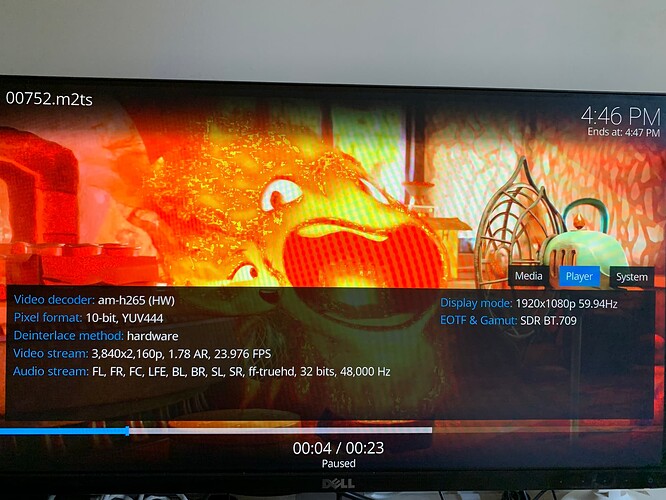Away from home at the moment. Will download and check on the weekend.
This image does not boot
I tried 2 Android versions, it doesn’t work
I know the boxes are older
I use them on 2 next to TVs
They are wall mounted and powered via USB from the TV
X3, X4 have significantly higher power consumption and do not work with USB power
So I have to stick with NG
When it does not work I will try to play with cpu voltage supply. rev.a did have some other values then rev.b SoC.
Wow! Thanks for your effort on the Amlogic-no version, it works well with HDR10+ on my A311D machine now! the related issue is here: Amlogic a311d and HDR10+ playback problem - #5 by Portisch
But I found it seems to broken the color of HDR10 in this version, while coreelec19~coreelec21 work well with HDR10.
photo:
video demo:
dmesg|paste: https://paste.coreelec.org/dgMDMB
I found all “high light/brightness scene” of hdr10 videos are incorrect,they are rendered as square color blocks.
BTW,the improvement of HDR10+ seems to be perfect,could it be merged into the normal version of amlogic-ng?(CoreELEC20.6-Nexus),that will be the perfect version!
no, NO is 5.15, NG is 4.9 EOL.
Because of the s905X2 problem with NO
(Android cannot be started, entry is missing)
I have freshly installed NG and NO on an SD card
NG works fine, NO doesn’t
Noticed a difference in the file system log:
In NO is the entry
/dev/loop0: BLOCK_SIZE=“524288” TYPE=“squashfs”
08_FilesystemNO.log (3.8 KB)
08_FilesystemNG.log (4.6 KB)
dmesg | paste
Tried your image but unfortunately the same result. Here is the UART Log:
I can tell you it did boot just once to the CE Main Menu, stayed there for about 10-15 secs and rebooted. Never was able to get that to happen again.
Hoping the logs find something helpful. Once again I appreciate all your help and time.
Then it’s maybe what I guess, the rev.a need another CPU voltage table then rev.b. I will try to setup a test DTB for you the next days.
@Portisch - My N2 board is Rev 0.4 20190327 and @tobetter has found the same rev board and can boot NO with no issues. Maybe it’s a borderline thing?
Please try with this dtb:
g12b_s922x_odroid_n2.dtb (72.0 KB)
I have an even older N2 board revision 0.4201190207 and today installed latest “NO” version on it via Sandisk 32GB uSD card without any problem. After finishing initial setup, installed my two usual addons (Keypad Editor and Multi Weather) set “WebDAV https” Protocol for my network locations, rebooted N2. After normal reboot, everything works as expected. It also boots from uSD card normally with latest Petitboot with switch in SPI position, as do my other OS-es on eMMC and USB.
Maybe there is something wrong with your uSD slot on your board…
@dev team:
Sadly I cannot use this “NO” version for daily use, because of constant jerky video when subtitles are enabled. This jerkiness goes back to initial “NO” versions.
Is there a way to fix this problem? Which elements should I include in debug logging that could shed more light to this behaviour.
This is known but no solution yet.
I just found out that each frame of a GUI item get rendered 78 times. Than this multiplied by the frame rate of the movie gives the count of render action per second… It’s to much CPU load.
So CPU goes from 3% to 15% as example. It’s a bad GUI rendering system bit optimized for low power systems. On like a x86 CPU you don’t have issues because of enough power.
This “issue” will be a big, long process to solve…
Thanx, no other option but patience, and in the mean time enjoy “NG” version.
I have seen and can reproduce this performance issue.
But no idea yet how to solve it. It’s related to the kernel libMali call eglSwapBuffers.
It is just called to many times as it take to long.
The number of calling it does not make sense for me anyway. Like when you stay in video window and file name is to long it start scrolling: CPU load 3% → 15%, only for this scrolling text. It’s unbelievable bad performance.
In my opinion the eglSwapBuffers should required called only once per frame, but not 78 times.
Yes it is really strange that only my N2 seems to have this problem. You could be right it being a hardware issue, like the uSD slot, but why would NG versions all boot just fine via the uSD?
My opinion is that it is hardware tolerances of some sort, like CPU voltages as @Portisch has mentioned, and some boards will be fine and others not. Will explain why I did get NO to boot correctly via uSD just once and only remain at the CE Main Menu for 10-15 secs before rebooting again.
I suspect more people will have the same problem as more and more start to use NO on their N2’s.
Did you try yet the DTB adjusted for rev.a?
Just tried it with the same results. Here is the UART with the kernel dump:
Was lucky it did boot up once and I got the UART:
